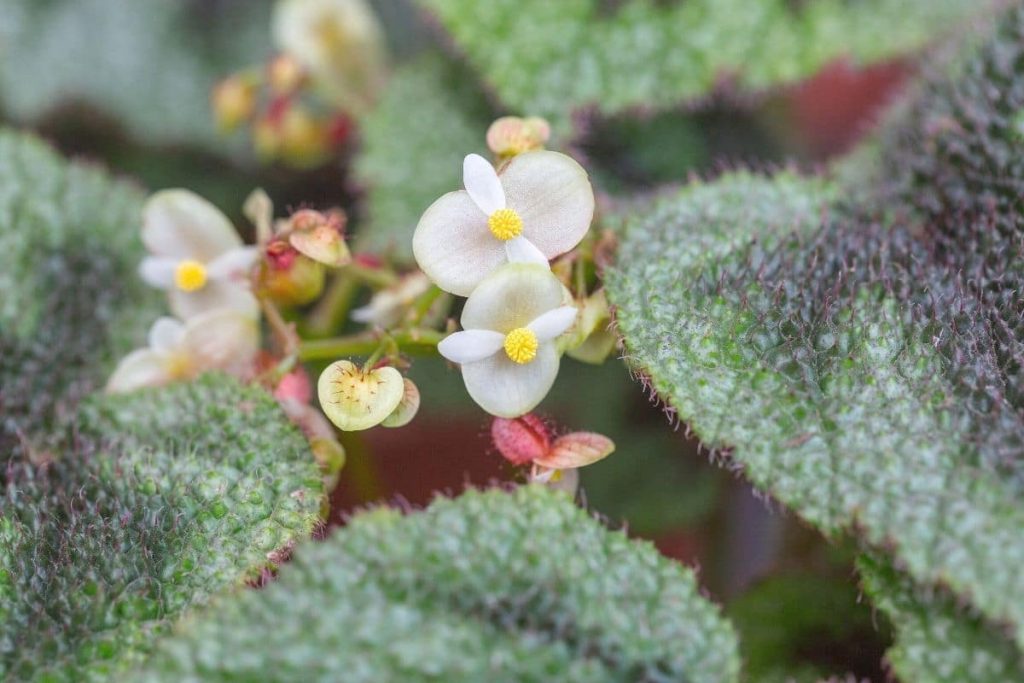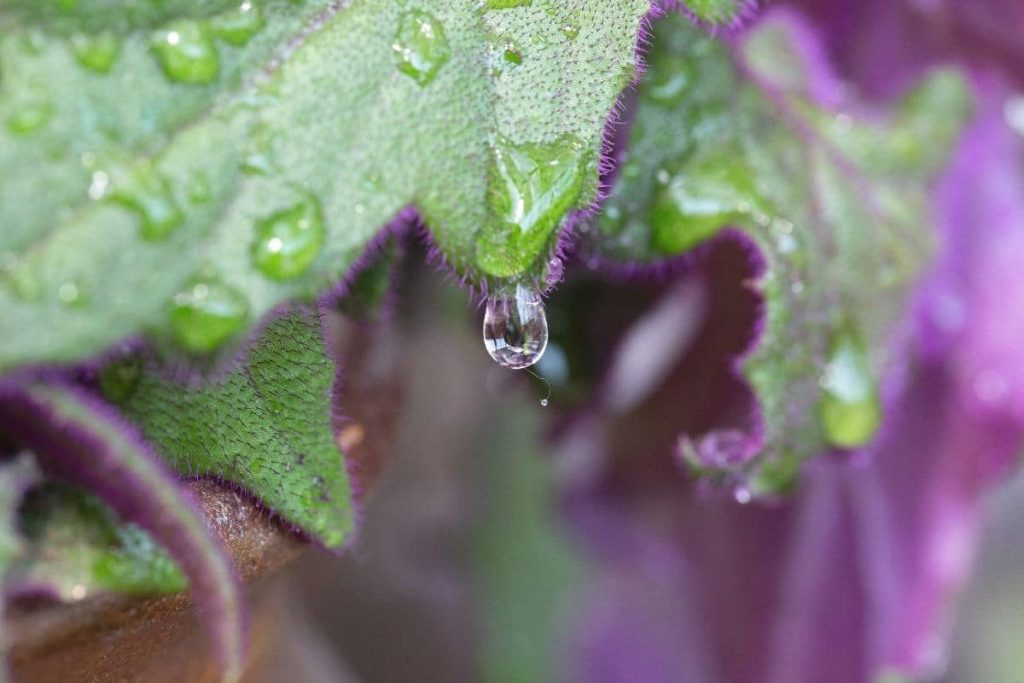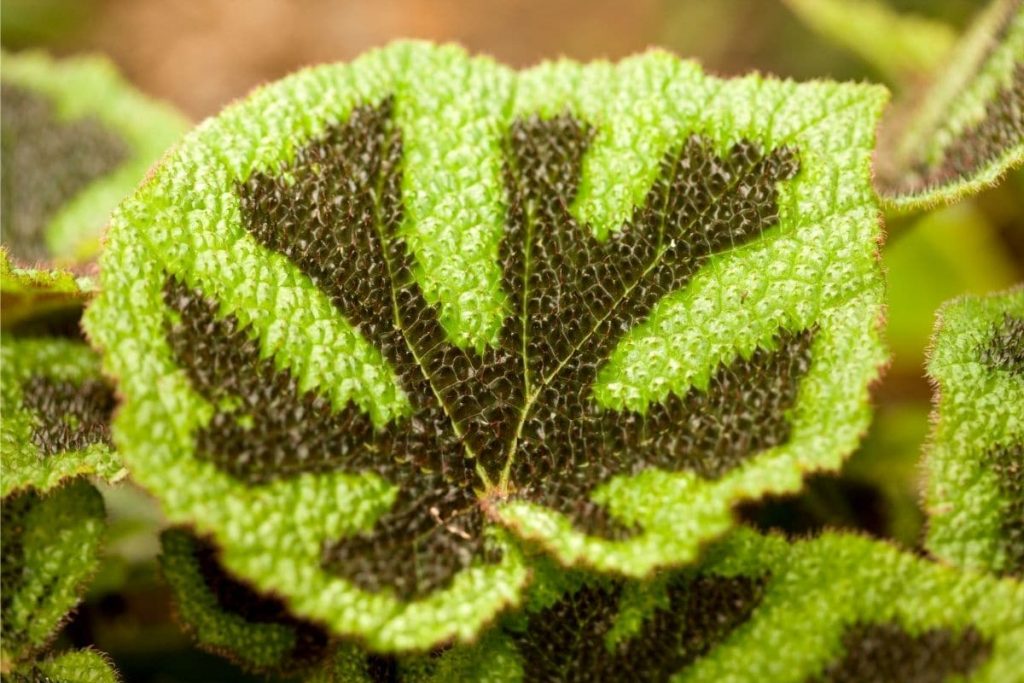Begonias are particularly popular and decorative houseplants in the local latitudes. They must be cultivated in tubs, as they require a lot of warmth due to their origin. A particularly beautiful variety is the iron cross begonia (Begonia masoniana), which originally comes from Vietnam.
Contents
- 1 Flowering and flowering time
- 2 Soil condition and location
- 3 Fertilizing and watering
- 4 Water from time to time even in winter
- 5 Diseases and pests
- 6 Plants
- 7 Cutting
- 8 Ready over winter
- 9 Repotting
- 10 Propagation
- 11 Frequently asked questions
- 12 Can I cultivate my Iron Cross begonia outside in summer?
- 13 How can I increase the humidity near the plant?
- 14 Is my Begonia masoniana poisonous?
- 15 What else do I need to consider when caring for it during the winter?
- 16 Author
Flowering and flowering time
The begonia, also known as the Iron Cross begonia, does not always flower. Its real ornament is the light green, hairy and textured leaves, which form a pattern in the middle, reminiscent of an iron cross, as it was used on the flags during the Crusades in the Middle Ages. Nevertheless, flowers may form sporadically:
- flowering between June and October
- small pink or white flowers
- hanging on long panicles

Soil condition and location
In terms of location, it is important to ensure that the decorative leaves are not exposed to full sunlight all day, as this does not suit them. However, a dark location should also be avoided, as the leaves would suffer from this as well, and the Iron Cross begonia would lose its decorative leaf markings here:
- East or west windowsill optimal
- with south window over midday hours blinds close
- optimal temperature: 18° to 22° Celsius
- in winter place in a cooler place
- 12° Celsius ideal
- cool, bright staircase
- high humidity desirable
- do not expose to direct heating air
- Soil permeable and humus
- compost soil recommended
- alternatively mix garden soil with peat
Tip: If you do not have a garden from which you can take the garden soil, you can also get compost from a well-stocked garden center or directly from a nursery. You can also get peat here.
Fertilizing and watering
During the winter, Begonia masoniana goes into dormancy. But after that it is important for good care to start fertilizing again in February or at the latest in March. Because then the plant sprouts new and needs sufficient nutrients for optimal growth:
- Use liquid fertilizer for foliage ornamental plants.
- follow manufacturer’s instructions when using
- as a rule, fertilize every two weeks
- water only moderately
- spray leaves with water from time to time
- use water with low lime content
- otherwise unattractive lime spots on leaf ornaments are the result
- Always keep the soil slightly moist
- avoid waterlogging
Water from time to time even in winter

Note: To prevent the plant from getting “wet feet” for too long after watering, it is a good idea to drain the drip tray about half an hour after watering.
Diseases and pests
Diseases are hardly known on the decorative iron cross begonia. Nevertheless, there are several mistakes in care that can cause a pattern of damage and diseases, and therefore should be avoided:
- brown and yellow leaves due to too much water.
- Remove the plant from the pot
- let roots dry out
- remove damaged roots
- put the plant in fresh substrate
- unsightly light spots on leaves
- due to too much sunlight
- possibly also in connection with spraying water
Place the plant out of the sun and only in a bright position
In winter, the Iron Cross begonia should also be checked more frequently for pests such as aphids, thrips or mites. If these occur, vigorous showering and quarantine of other plants is a good idea to prevent the pests from jumping over. In the worst case, insecticides can be used.
Tip: If you can only offer your Begonia masoniana a location where the sun comes in from time to time, you should refrain from spraying the leaves. This is because the small drops of water act like a magnifying glass and burn the decorative leaves if the sunlight falls here even briefly.
Plants
Either the begonias obtained by propagation can be planted in a new container, or get a ready-made plant from the store. However, this must also be taken out of the supplied pot early, because in this the keeping conditions are not given for a longer time:
- Choose a sufficiently large pot (15% larger than the original pot).
- Roots should have enough space all around
- Create drainage against waterlogging
- clay balls or shards over drainage hole
- plant fleece over it
- fill in half of prepared or purchased soil
- Remove plant pot with soil
- loosen roots slightly, remove too much soil
- place in new pot
- fill in the remaining soil and water lightly
Cutting
Begonia masoniana does not require pruning. Only when old leaves appear, which have turned yellow or brown, they should be removed directly:
- Reconsider care if leaves are discolored
- Plant may have received too much water
- remove leaves for decorative value
- also remove any withered leaves directly
- so energy can be concentrated on “living” again
Ready over winter
Iron Cross begonia, like all begonia species, is not hardy. However, since it is strictly an indoor plant in our local latitudes, winter care is quite simple:
- Bring pot to cooler place
- not below 12° Celsius
- avoid heating air
- too dry for plant
- place in a bright place without sunlight
- do not fertilize from October
- water moderately over winter
Tip: If you can put the Iron Cross begonia in a bright stairwell or other bright unheated room in the winter, it is optimal for the plant. An unheated winter garden is also a good option. However, if such a thing is not available, then you should place the plant far away from a heater.
Repotting
Begonia masoniana forms rhizomes. The roots grow very quickly this way and require a larger pot every two years at the latest. However, they can also be divided and planted in different pots. It is also important to replace the soil so that it remains well-drained and does not become compacted over the years:
- Ideal time in the spring.
- roots can recover more quickly
- if the entire plant is repotted, new tub 15% larger
- in case of division, plant can be returned to original pot
- Replace the soil altogether
- proceed as described under “Plants
Propagation
Begonia masoniana can be propagated in two different ways. First, during the process of repotting, the rhizome can be divided into several parts. Among other things, this then has the effect of rejuvenation. And also through the leaves as cuttings, the plant can be propagated:
- When dividing, make sure the knife is clean and sharp.
- remove soil from the root
- divide into two or three pieces
- replant all plants in one pot each
- for leaf propagation choose a healthy leaf
- cut into several small pieces
- put them diagonally into potting soil
- keep slightly moist
- rooted within a short time

If the leaf propagation is used, this is a simple method, because the original plant is completely unaffected by this, except for the removal of one or two leaves. The appropriate period for both methods is spring. When dividing before leaf sprouting and when removing leaves, of course, after.
Frequently asked questions
Can I cultivate my Iron Cross begonia outside in summer?
If it has become warm enough in May after the Ice Saints, there is nothing to prevent you from moving the plant in a pot to a sheltered spot. But even here you should make sure that Begonia masoniana is not too warm and especially not exposed to direct sunlight. It can also be too dry for the foliage ornamental plant outside in the summer.
How can I increase the humidity near the plant?
There are several ways to increase the humidity. Either, you place bowls of water right next to the Iron Cross begonia. The water will evaporate and arrive directly at the leaves. An electric humidifier is also a good solution, because you can set it to the exact humidity you want. Alternatively, you can also dust the plant with water on the leaves in between.
Is my Begonia masoniana poisonous?
Unfortunately, all species of begonias have a slightly toxic sap that comes out when a leaf is removed or a style is injured. Therefore, you should place the plants high enough if there are small children or pets in your home that could break off leaves or, in the case of animals, nibble on the plant.
What else do I need to consider when caring for it during the winter?
It is not uncommon for Begonia masoniana to retreat completely into your roots for winter dormancy. If this is also the case with your plant, winter care is even easier. Cover the pot with clear plastic or a hood made of glass. Under this, it will remain sufficiently moist and you will hardly need to water. When the first leaf shoots appear in late winter, the hood is simply removed again and the usual care throughout the year begins.

